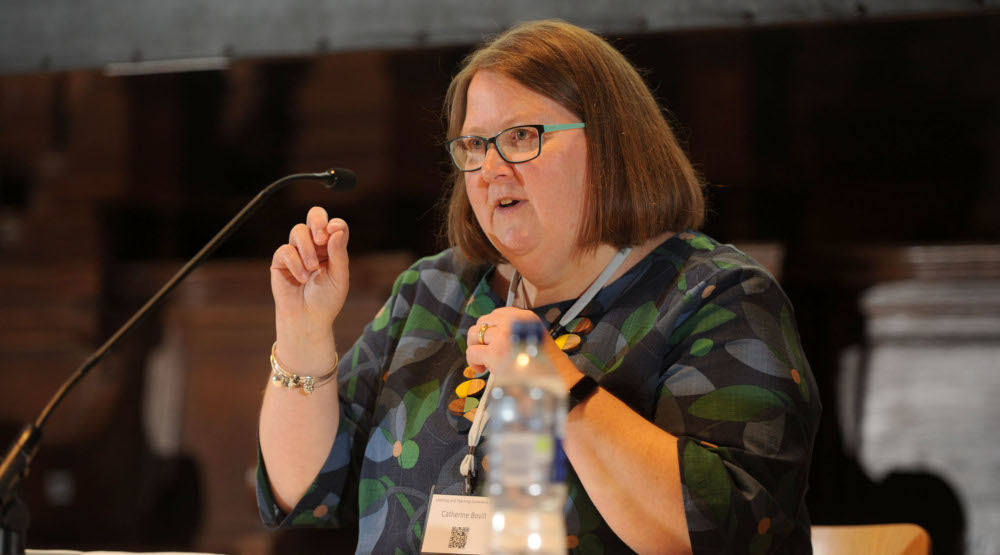
Dr Catherine Bovill delivering her keynote talk at the Learning & Teaching Conference, McEwan Hall. All images credited to Allan Bovill Photography.
In this post, Dr Catherine Bovill summarises her keynote talk presented at the Learning and Teaching Conference: “Shaping the future curriculum with students”. This post is part of the Hot Topic: Learning and Teaching Conference 2022.
It has been exciting to hear colleagues talking more regularly about curriculum over the last year in response to the University’s Curriculum Transformation Programme. I’ve also enjoyed working with colleagues from Edinburgh University Students’ Association, and from across the University, to enable multiple opportunities for students to be meaningful partners in those conversations. Ensuring that students are contributors to our conversations about curriculum was the focus of the keynote presentation I gave at The University of Edinburgh’s Learning and Teaching Conference 2022.
I began my presentation by proposing that universities are ‘better’ when they work together with students. I realise this is a contentious claim, but I draw on a range of evidence to argue that student involvement has been linked to a range of benefits. For example, based on rigorous research into student learning 40 years ago, Astin claimed that:
The amount of student learning and personal development associated with any educational program is directly proportional to the quality and quantity of student involvement in that program. The effectiveness of any educational policy or practice is directly related to the capacity of that policy or practice to increase student involvement (Astin 1984 p. 298).
There are also arguments made for students to be involved in decisions about their education because they are a key stakeholder in, as well as a central focus of, universities (Barrineau et al 2019). In my own experience, students are also smart and highly creative, and often exceed our expectations if we communicate high expectations of their capabilities.
One key way we can shape the future curriculum with students is to co-create the curriculum. In simple terms, this means that students are invited to share decision-making about curriculum design before a course or programme takes place or during a course (this can involve sharing decisions about elements of teaching, learning, and assessment).
Of course, how we define curriculum influences what we are inviting students to co-create (Bovill & Woolmer, 2019). And this leads to a searching question for us all to ask as we undertake the Curriculum Transformation Programme: How are we defining curriculum? There may be many answers to this question within our diverse staff and student community. This is why examples of co-created curriculum can be so diverse, such as: students and staff working together to decolonise a course; students designing and recording videos for use in flipped teaching; students and staff contributing to a shared PowerPoint pack; or co-designing essay titles. For more examples and information about defining co-created curriculum, please see the keynote presentation recording:
One of the reasons we should take co-created curriculum seriously is the growing evidence of beneficial outcomes. Benefits include: enhanced motivation and learning; deeper meta-cognitive awareness of learning and teaching; a more developed sense of identity; improved teaching and classroom experiences; enhanced belonging, relationships, confidence, and trust; enhanced academic performance; increased sense of feeling valued; practice at working democratically; increased relevance; more culturally responsive and inclusive practices; and co-created assessment leading to a shift in focus from grades to learning (See for example Cook-Sather, Bovill & Felten, 2014; Mercer-Mapstone et al, 2017; Deeley & Bovill, 2017).
Recent research into over 10 different examples of co-created curriculum in Scotland also found: students reporting that the co-created course they took was their best course at university; many teachers described positive transformation in assessment performance for students who had previously performed less well; and importantly, a small number of students decided not to drop out of university, motivated to stay by their engagement with co-created curricula (Lubicz-Nawrocka and Bovill 2021).
The bed-rock of co-created curriculum is positive student-staff relationships: “Frequent and high quality student–instructor interactions are one of the most empirically supported educational best practices in higher education” (Bingham et al 2021, p13). Indeed, student-staff interaction is consistently associated with academic success, retention, motivation, academic self-concept, well-being, mattering (Bovill, 2020; Cuseo 2018; Felten & Lambert 2021). Time taken to create an environment in which relationships can develop is time well spent – even an apparently small thing, such as learning students’ names, can have an enormous positive impact on students’ sense of mattering and belonging. Cooper et al (2017) describe how they used ‘name tents’ (pieces of paper folded in half with the student’s first name written in large letters on it) in large classes, and staff would use students’ names when asking a question or inviting involvement in class (and, of course, students were enabled to learn other students’ names). They found statistically significant results that the use of name tents enhanced student motivation and learning, and made it more likely students would approach staff to ask for help. Students understood that staff could not remember hundreds of students’ names, but the research findings highlighted that the practice of teachers making an effort to call students by their name demonstrated to students that staff cared enough to try to learn their names, and this seems to have a positive impact on students’ experiences.
Many staff and student colleagues will already be building positive relationships built on trust and shared respect. Many colleagues are co-creating whole courses or elements of courses with students. But for some other staff and students, this will feel like a big shift from the teaching, learning, assessment, course and programme design they are used to. Shaping the future curriculum with students will involve shifts in mind-set, which take time. We are at an exciting stage in the history of The University of Edinburgh, where we have the potential to redefine the ways we shape the curriculum with students, not just for the next few years, but for many years into the future. It can be helpful to regularly ask ourselves, where are the students in this conversation? Are there particular students missing from our conversations? We could also ask ourselves, where do staff and students learn about curriculum?
I concluded by suggesting a small change to my first proposition: Universities are better when WE work together with students. This recognises that we all part of the University, and we all contribute to the current way things are done, as well as having the potential to influence and transform the University. We need to strive for a shift from students feeling that the curriculum is something done to them, towards working with students to envision and enact our future curriculum.
References
Astin, A. W. (1984) Student involvement: A developmental theory for higher education. Journal of College Student Personnel 25 (4) 297–308.
Barrineau, S, Engstrom, A and Schnaas, U (2019) An Active Student Participation Companion. Uppsala: Uppsala University: www.diva-portal.org/smash/get/diva2:1286438/FULLTEXT02.pdf
Bingham, B.E., Rea, V., Robertson, L., Smith, M.A. & Jacobs, S. (2021) Frequency, topic, and preferences: Tracking student engagement with several modalities of student–instructor contact in a first-year course. Federation of European Biochemical Societies FEBS OpenBio 16 October: https://doi.org/10.1002/2211-5463.13315
Bovill, C. (2020) Co-creation in learning and teaching: the case for a whole-class approach in higher education. Higher Education 79 (6) 1023-1037.
Bovill, C. & Woolmer, C. (2019) How conceptualisations of curriculum in higher education influence student-staff co-creation in and of the curriculum. Higher Education 78 (3) 407-422.
Cook-Sather, A., Bovill, C., Felten, P. (2014) Engaging students as partners in learning and teaching: a guide for faculty. San Francisco: Jossey Bass.
Cooper, K.M., Haney, B., Krieg, A. and Brownell, S.E. (2017) What’s in a name? The importance of students perceiving that an instructor knows their names in a high-enrollment biology classroom. CBE-Life Sciences Education, 16: 1–13.
Cuseo, J. (2007) The empirical case against large class size: adverse effects on the teaching, learning and retention of first-year students. The Journal of Faculty Development 21 (1) 5-21.
Deeley, S. J., & Bovill, C. (2017) Staff-student partnership in assessment: enhancing assessment literacy through democratic practices. Assessment and Evaluation in Higher Education 42(3) 463–477.
Felten, P. and Lambert, L. (2020) Relationship-rich education. How human connections drive success in college. Baltimore: Johns Hopkins University Press.
Lubicz-Nawrocka, T. and Bovill, C. (2021) Do students experience transformation through co-creating curriculum in higher education? Teaching in Higher Education. Onlinefirst: https://www.tandfonline.com/doi/full/10.1080/13562517.2021.1928060
Mercer-Mapstone, L., Dvorakova, S.L., Matthews,K.E., Abbot, S., Cheng, B., Felten, P., Knorr, K., Marquis, E., Shammas, R. and Swaim. K. (2017) A Systematic Literature Review of Students as Partners in Higher Education. International Journal for Students as Partners 1 (1) 1–23.
Catherine Bovill
Dr Catherine Bovill is Senior Lecturer in Student Engagement at the Institute for Academic Development (IAD), University of Edinburgh. She is also Visiting Fellow at the University of Bergen, Norway, Visiting Fellow at the University of Winchester, UK, and previously a Fulbright Scholar. She is a Principal Fellow of the Higher Education Academy and Fellow of the Staff and Educational Development Association. Cathy is co-chair of the Curriculum Transformation Programme Student Engagement Strategy Group, leads the IAD programme and course design team, and leads the UoE Student Partnership Agreement and funding scheme. Her research focuses on co-created curriculum, student-staff partnership and student engagement.



